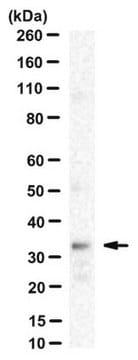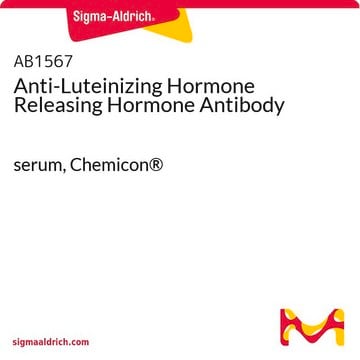MAB5456-C
Anti-Gonadotropin-Releasing Hormone Antibody, NT, clone HU11B (Ascites Free)
clone HU11B, from mouse
Sinónimos:
Gonadotropin-releasing hormone I, GnRH-I, Luliberin I, Luteinizing hormone-releasing hormone I, LH-RH I
About This Item
Productos recomendados
biological source
mouse
Quality Level
antibody form
purified immunoglobulin
antibody product type
primary antibodies
clone
HU11B, monoclonal
species reactivity
human, rat, rhesus macaque, mouse
technique(s)
affinity binding assay: suitable
electron microscopy: suitable
immunofluorescence: suitable
immunohistochemistry: suitable (paraffin)
isotype
IgG1κ
NCBI accession no.
UniProt accession no.
shipped in
wet ice
target post-translational modification
unmodified
Gene Information
human ... GNRH1(2796)
General description
Specificity
Immunogen
Application
Affinity Binding Assay: A representative lot captured C-terminally blocked GnRH-I/LHRH (LHRH-NH2), but not LHRH with a free C-terminal end (LHRH-COOH). Clone HU11B exhibited reduced affinity toward N-terminally truncated LHRH-NH2 and failed to recognize pro-LHRH, Atrial Naturetic Factor/ANF, Growth hormone-releasing hormone/GHRH, Oxytocin, Somatostatin, Thyrotropin-releasing hormone/TRH, and Vasoactive intestinal peptide/VIP (Urbanski, H.F., et al. (1991). Biol. Reprod. 44(4):681-686).
Immunofluorescence Analysis: A representative lot detected GnRH neurons in brain sections from female rhesus monkeys by fluorescent immunohistochemistry (Naugle, M.M., and Gore, A.C. (2014). Neuroendocrinology 100:334-346).
Immunofluorescence Analysis: A representative lot detected pregnancy stage-dependent GnRH-I immunoreactivity in the luminal epithelium of rat oviduct by fluorescent immunohistochemistry using paraformaldehyde-fixed cryosections (Sengupta, A., et al. (2007). J. Histochem. Cytochem. 55(5):525-534).
Immunofluorescence Analysis: A representative lot detected GnRH-I immunoreactivity in frozen mouse hypothalamic sections by fluorescent immunohistochemistry (Olcese, J., et al. (2003). Neuroreport. 14(4):613-618).
Electron Microscopy: A representative lot detected GnRH-I immunoreactivity associated with the luminal epithelium secretory vesicles of rat oviduct by EM using paraformaldehyde-fixed LR wihite sections from rats at day 16 of pregnancy (Sengupta, A., et al. (2007). J. Histochem. Cytochem. 55(5):525-534).
Immunohistochemistry Analysis: A representative lot detected GnRH-I immunoreactivity throughout the hypothalamus in paraformalin-fixed, paraffin-embedded South American plains vizcacha (Lagostomus maximus) brain sections (Dorfman, V.B., et al. (2011). J. Mol. Histol. 42(4):311-321).
Immunohistochemistry Analysis: A representative lot detected GnRH-I-positie neurons in formalin-fixed, paraffin-embedded mouse brain sections (Bergman, J.E., et al. (2010). Eur. J. Hum. Genet. 18(2):171-177).
Immunohistochemistry Analysis: A representative lot detected GnRH-I immunoreactivity in paraformaldehyde-fixed rat brain vibratome sections (Urbanski, H.F., et al. (1991). Biol. Reprod. 44(4):681-686).
Neuroscience
Developmental Neuroscience
Quality
Immunohistochemistry Analysis: A 1:50 dilution of this antibody detected Gonadotropin-Releasing Hormone in human prostate tissue.
Target description
Physical form
Storage and Stability
Other Notes
Disclaimer
Not finding the right product?
Try our Herramienta de selección de productos.
Storage Class
12 - Non Combustible Liquids
wgk_germany
WGK 1
flash_point_f
Not applicable
flash_point_c
Not applicable
Certificados de análisis (COA)
Busque Certificados de análisis (COA) introduciendo el número de lote del producto. Los números de lote se encuentran en la etiqueta del producto después de las palabras «Lot» o «Batch»
¿Ya tiene este producto?
Encuentre la documentación para los productos que ha comprado recientemente en la Biblioteca de documentos.
Nuestro equipo de científicos tiene experiencia en todas las áreas de investigación: Ciencias de la vida, Ciencia de los materiales, Síntesis química, Cromatografía, Analítica y muchas otras.
Póngase en contacto con el Servicio técnico







